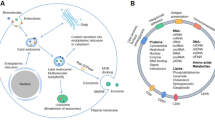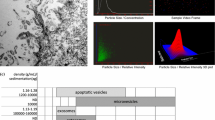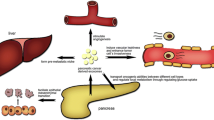Abstract
Exosomes are nanovesicles shed by cells as a means of communication with other cells. Exosomes contain mRNAs, microRNAs (miRs) and functional proteins. In the present paper, we develop a mathematical model of tumor–immune interaction by means of exosomes shed by pancreatic cancer cells and dendritic cells. Cancer cells’ exosomes contain miRs that promote their proliferation and that inhibit immune response by dendritic cells, and by CD4+ and CD8+ T cells. Dendritic cells release exosomes with proteins that induce apoptosis of cancer cells and that block regulatory T cells. Simulations of the model show how the size of the pancreatic cancer can be determined by measurement of specific miRs (miR-21 and miR-203 in the case of pancreatic cancer), suggesting these miRs as biomarkers for cancer.





Similar content being viewed by others
References
An T, Qin S, Xu Y, Tang Y, Huang Y, Situ B, Inal JM, Zheng L (2015) Exosomes serve as tumour markers for personalized diagnostics owing to their important role in cancer metastasis. J Extracell Vesicles 4:27522
Bader AG, Brown D, Stoudemire J, Lammers P (2011) Developing therapeutic microRNAs for cancer. Gene Ther 18(12):1121–1126
Balaj L, Lessard R, Dai L, Cho YJ, Pomeroy SL, Breakefield XO, Skog J (2011) Tumour microvesicles contain retrotransposon elements and amplified oncogene sequences. Nat Commun 2:180
Berktas M, Guducuoglu H, Bozkurt H, Onbasi KT, Kurtoglu MG, Andic S (2004) Change in serum concentrations of interleukin-2 and interferon-gamma during treatment of tuberculosis. J Int Med Res 32(3):324–330
Celik O, Kutlu O, Tekcan M, Celik-Ozenci C, Koksal IT (2013) Role of TNF-related apoptosis-inducing ligand (TRAIL) in the pathogenesis of varicocele-induced testicular dysfunction. Asian J Androl 15(2):269–274
Cheng W, Liu F, Wang Z, Zhang Y, Zhao YX, Zhang Q, Jiang F (2015) Soluble TRAIL concentration in serum is elevated in people with hypercholesterolemia. PLoS ONE 10(12):e0144015
Chevillet JR, Kang Q, Ruf IK, Briggs HA, Vojtech LN et al (2014) Quantitative and stoichiometric analysis of the microRNA content of exosomes. Proc Natl Acad Sci USA 111(41):14888–14893
Cosio MG, Majo J, Cosio MG (2002) Inflammation of the airways and lung parenchyma in COPD: role of T cells. Chest 121(5 Suppl):160S–165S
Coventry BJ, Lee PL, Gibbs D, Hart DN (2002) Dendritic cell density and activation status in human breast cancer: CD1a, CMRF-44, CMRF-56 and CD-83 expression. Br J Cancer 86(4):546–551
Day J, Friedman A, Schlesinger LS (2009) Modeling the immune rheostat of macrophages in the lung in response to infection. Proc Natl Acad Sci USA 106(27):11246–11251
de Sousa Cavalcante L, Monteiro G (2014) Gemcitabine: metabolism and molecular mechanisms of action, sensitivity and chemoresistance in pancreatic cancer. Eur J Pharmacol 741:8–16
Derin D, Soydinc HO, Guney N, Tas F, Camlica H, Duranyildiz D, Yasasever V, Topuz E (2007) Serum IL-8 and IL-12 levels in breast cancer. Med Oncol 24(2):163–168
Ding G, Zhou L, Qian Y, Fu M, Chen J, Chen J, Xiang J, Wu Z, Jiang G, Cao L (2015) Pancreatic cancer-derived exosomes transfer miRNAs to dendritic cells and inhibit RFXAP expression via miR-212-3p. Oncotarget. doi:10.18632/oncotarget.4924
Eden U, Fagerholm P, Danyali R, Lagali N (2012) Pathologic epithelial and anterior corneal nerve morphology in early-stage congenital aniridic keratopathy. Ophthalmology 119(9):1803–1810
Ellerman JE, Brown CK, de Vera M, Zeh HJ, Billiar T, Rubartelli A, Lotze MT (2007) Masquerader: high mobility group box-1 and cancer. Clin Cancer Res 13(10):2836–2848
Fadeev RS, Chekanov AV, Dolgikh NV, Akatov VS (2012) Increase in resistance of A431 cancer cells to TRAIL-induced apoptosis in confluent cultures. Biofizika 57(4):649–654
Falcone G, Felsani A, D’Agnano I (2015) Signaling by exosomal microRNAs in cancer. J Exp Clin Cancer Res 34:32
Gercel-Taylor C, Atay S, Tullis RH, Kesimer M, Taylor DD (2012) Nanoparticle analysis of circulating cell-derived vesicles in ovarian cancer patients. Anal Biochem 428(1):44–53
Halkova T, Cuperkova R, Minarik M, Benesova L (2015) MicroRNAs in pancreatic cancer: involvement in carcinogenesis and potential use for diagnosis and prognosis. Gastroenterol Res Pract 2015:892903
Hao W, Crouser ED, Friedman A (2014) Mathematical model of sarcoidosis. Proc Natl Acad Sci USA 111(45):16065–16070
Hao W, Friedman A (2014) The LDL-HDL profile determines the risk of atherosclerosis: a mathematical model. PLoS ONE 9(3):e90497
Hellerstein M, Hanley MB, Cesar D, Siler S, Papageorgopoulos C, Wieder E, Schmidt D, Hoh R, Neese R, Macallan D, Deeks S, McCune JM (1999) Directly measured kinetics of circulating T lymphocytes in normal and HIV-1-infected humans. Nat Med 5(1):83–89
Henry CJ, Ornelles DA, Mitchell LM, Brzoza-Lewis KL, Hiltbold EM (2008) IL-12 produced by dendritic cells augments CD8+ T cell activation through the production of the chemokines CCL1 and CCL17. J Immunol 181(12):8576–8584
Hosgood HD, Zhang L, Tang X, Vermeulen R, Qiu C, Shen M, Smith MT, Ge Y, Ji Z, Xiong J, He J, Reiss B, Liu S, Xie Y, Guo W, Galvan N, Li L, Hao Z, Rothman N, Huang H, Lan Q (2011) Decreased numbers of CD4(+) naive and effector memory T cells, and CD8(+) naive T cells, are associated with trichloroethylene exposure. Front Oncol 1:53
Ikenaga N, Ohuchida K, Mizumoto K, Yu J, Kayashima T, Sakai H, Fujita H, Nakata K, Tanaka M (2010) MicroRNA-203 expression as a new prognostic marker of pancreatic adenocarcinoma. Ann Surg Oncol 17(12):3120–3128
Kang R, Tang D, Schapiro NE, Loux T, Livesey KM, Billiar TR, Wang H, Van Houten B, Lotze MT, Zeh HJ (2014) The HMGB1/RAGE inflammatory pathway promotes pancreatic tumor growth by regulating mitochondrial bioenergetics. Oncogene 33(5):567–577
Komatsu S, Ichikawa D, Takeshita H, Tsujiura M, Morimura R, Nagata H, Kosuga T, Iitaka D, Konishi H, Shiozaki A, Fujiwara H, Okamoto K, Otsuji E (2011) Circulating microRNAs in plasma of patients with oesophageal squamous cell carcinoma. Br J Cancer 105(1):104–111
Liao KL, Bai XF, Friedman A (2014) Mathematical modeling of interleukin-27 induction of anti-tumor T cells response. PLoS ONE 9(3):e91844
Liao KL, Bai XF, Friedman A (2014) Mathematical modeling of Interleukin-35 promoting tumor growth and angiogenesis. PLoS ONE 9(10):e110126
Lin J, Li J, Huang B, Liu J, Chen X, Chen XM, Xu YM, Huang LF, Wang XZ (2015) Exosomes: novel biomarkers for clinical diagnosis. Sci World J 2015:657086
Ma Y, Shurin GV, Peiyuan Z, Shurin MR (2013) Dendritic cells in the cancer microenvironment. J Cancer 4(1):36–44
MacGill M (2013) Pancreatic cancer: chemo drug Gemzar improves survival rates. Medical News Today
Mantegazza AR, Zajac AL, Twelvetrees A, Holzbaur EL, Amigorena S, Marks MS (2014) TLR-dependent phagosome tubulation in dendritic cells promotes phagosome cross-talk to optimize MHC-II antigen presentation. Proc Natl Acad Sci USA 111(43):15508–15513
McDonald D (2010) Understanding miRNA turnover: a study of miRNA half-life. Broad Insitute, Cambridge
Melo SA, Sugimoto H, O’Connell JT, Kato N, Villanueva A, Vidal A, Qiu L, Vitkin E, Perelman LT, Melo CA, Lucci A, Ivan C, Calin GA, Kalluri R (2014) Cancer exosomes perform cell-independent microRNA biogenesis and promote tumorigenesis. Cancer Cell 26(5):707–721
Merino D, Lalaoui N, Morizot A, Solary E, Micheau O (2007) TRAIL in cancer therapy: present and future challenges. Expert Opin Ther Targets 11(10):1299–1314
Michalaki V, Syrigos K, Charles P, Waxman J (2004) Serum levels of IL-6 and TNF-alpha correlate with clinicopathological features and patient survival in patients with prostate cancer. Br J Cancer 90(12):2312–2316
Muller N, Schneider B, Pfizenmaier K, Wajant H (2010) Superior serum half life of albumin tagged TNF ligands. Biochem Biophys Res Commun 396(4):793–799
Munich S, Sobo-Vujanovic A, Buchser WJ, Beer-Stolz D, Vujanovic NL (2012) Dendritic cell exosomes directly kill tumor cells and activate natural killer cells via TNF superfamily ligands. Oncoimmunology 1(7):1074–1083
Oliver JC, Bland LA, Oettinger CW, Arduino MJ, McAllister SK, Aguero SM, Favero MS (1993) Cytokine kinetics in an in vitro whole blood model following an endotoxin challenge. Lymphokine Cytokine Res 12(2):115–120
Palucka K, Banchereau J (2012) Cancer immunotherapy via dendritic cells. Nat Rev Cancer 12(4):265–277
Pang Y, Young CY, Yuan H (2010) MicroRNAs and prostate cancer. Acta Biochim Biophys Sin (Shanghai) 42(6):363–369
Pilch J, Namysłowski G, Scierski W, Urbaniec P, Sowińska-Krzyzanowska I (2006) Interleukin 2 concentration changes in the laryngeal cancer patients during the surgical treatment. Otolaryngol Pol 60(3):331–336
Properzi F, Logozzi M, Fais S (2013) Exosomes: the future of biomarkers in medicine. Biomark Med 7(5):769–778
Purwar R, Campbell J, Murphy G, Richards WG, Clark RA, Kupper TS (2011) Resident memory T cells (T(RM)) are abundant in human lung: diversity, function, and antigen specificity. PLoS ONE 6(1):e16245
Rabinowits G, Gercel-Taylor C, Day JM, Taylor DD, Kloecker GH (2009) Exosomal microRNA: a diagnostic marker for lung cancer. Clin Lung Cancer 10(1):42–46
Ren Y, Zhou X, Mei M, Yuan XB, Han L, Wang GX, Jia ZF, Xu P, Pu PY, Kang CS (2010) MicroRNA-21 inhibitor sensitizes human glioblastoma cells U251 (PTEN-mutant) and LN229 (PTEN-wild type) to taxol. BMC Cancer 10:27
Riches A, Campbell E, Borger E, Powis S (2014) Regulation of exosome release from mammary epithelial and breast cancer cells: a new regulatory pathway. Eur J Cancer 50(5):1025–1034
Ru P, Steele R, Hsueh EC, Ray RB (2011) Anti-miR-203 upregulates SOCS3 expression in breast cancer cells and enhances cisplatin chemosensitivity. Genes Cancer 2(7):720–727
Saenz R, Futalan D, Leutenez L, Eekhout F, Fecteau JF, Sundelius S, Sundqvist S, Larsson M, Hayashi T, Minev B, Carson D, Esener S, Messmer B, Messmer D (2014) TLR4-dependent activation of dendritic cells by an HMGB1-derived peptide adjuvant. J Transl Med 12:211
Schultz NA, Dehlendorff C, Jensen BV, Bjerregaard JK, Nielsen KR, Bojesen SE, Calatayud D, Nielsen SE, Yilmaz M, Hollander NH, Andersen KK, Johansen JS (2014) MicroRNA biomarkers in whole blood for detection of pancreatic cancer. JAMA 311(4):392–404
Sheen-Chen SM, Chen WJ, Eng HL, Chou FF (1997) Serum concentration of tumor necrosis factor in patients with breast cancer. Breast Cancer Res Treat 43(3):211–215
Shui YB, Wang X, Hu JS, Wang SP, Garcia CM et al (2003) Vascular endothelial growth factor expression and signaling in the lens. Invest Ophthalmol Vis Sci 44(9):3911–3919
Sicard F, Gayral M, Lulka H, Buscail L, Cordelier P (2013) Targeting miR-21 for the therapy of pancreatic cancer. Mol Ther 21(5):986–994
Sims GP, Rowe DC, Rietdijk ST, Herbst R, Coyle AJ (2010) HMGB1 and RAGE in inflammation and cancer. Annu Rev Immunol 28:367–388
Sonkoly E, Wei T, Pavez Lorie E, Suzuki H, Kato M, Torma H, Stahle M, Pivarcsi A (2010) Protein kinase C-dependent upregulation of miR-203 induces the differentiation of human keratinocytes. J Invest Dermatol 130(1):124–134
Sonkoly E, Loven J, Xu N, Meisgen F, Wei T, Brodin P, Jaks V, Kasper M, Shimokawa T, Harada M, Heilborn J, Hedblad MA, Hippe A, Grander D, Homey B, Zaphiropoulos PG, Arsenian-Henriksson M, Stahle M, Pivarcsi A (2012) MicroRNA-203 functions as a tumor suppressor in basal cell carcinoma. Oncogenesis 1:e3
Szomolay B, Eubank T, Roberts RD, Marsh CB, Friedman A (2012) Modeling the inhibition of breast cancer growth by GM-CSF. J Theor Biol 303:141–151
Tanaka Y, Kamohara H, Kinoshita K, Kurashige J, Ishimoto T, Iwatsuki M, Watanabe M, Baba H (2013) Clinical impact of serum exosomal microRNA-21 as a clinical biomarker in human esophageal squamous cell carcinoma. Cancer 119(6):1159–1167
Tang D, Kang R, Zeh HJ, Lotze MT (2010) High-mobility group box 1 and cancer. Biochim Biophys Acta 1799(1–2):131–140
Taylor DD, Gercel-Taylor C (2008) MicroRNA signatures of tumor-derived exosomes as diagnostic biomarkers of ovarian cancer. Gynecol Oncol 110(1):13–21
Troy AJ, Summers KL, Davidson PJ, Atkinson CH, Hart DN (1998) Minimal recruitment and activation of dendritic cells within renal cell carcinoma. Clin Cancer Res 4(3):585–593
Valencia X, Stephens G, Goldbach-Mansky R, Wilson M, Shevach EM, Lipsky PE (2006) TNF downmodulates the function of human CD4+CD25hi T-regulatory cells. Blood 108(1):253–261
Waage A, Brandtzaeg P, Halstensen A, Kierulf P, Espevik T (1989) The complex pattern of cytokines in serum from patients with meningococcal septic shock. Association between interleukin 6, interleukin 1, and fatal outcome. J Exp Med 169(1):333–338
Wada R, Akiyama Y, Hashimoto Y, Fukamachi H, Yuasa Y (2010) miR-212 is downregulated and suppresses methyl-CpG-binding protein MeCP2 in human gastric cancer. Int J Cancer 127(5):1106–1114
Wang C, Zheng X, Shen C, Shi Y (2012) MicroRNA-203 suppresses cell proliferation and migration by targeting BIRC5 and LASP1 in human triple-negative breast cancer cells. J Exp Clin Cancer Res 31:58
Whitcomb DC (2004) Inflammation and Cancer V. Chronic pancreatitis and pancreatic cancer. Am J Physiol Gastrointest Liver Physiol 287(2):G315–319
Whiteside TL (2013) Immune modulation of T-cell and NK (natural killer) cell activities by TEXs (tumour-derived exosomes). Biochem Soc Trans 41(1):245–251
Xu M, Gu M, Zhang K, Zhou J, Wang Z, Da J (2015) miR-203 inhibition of renal cancer cell proliferation, migration and invasion by targeting of FGF2. Diagn Pathol 10:24
Young ME, Carroad PA, Bell RL (1980) Estimation of diffusion coefficients of proteins. Biotechnol Bioeng 22(5):947–955
Zhang J, Li S, Li L, Li M, Guo C, Yao J, Mi S (2015a) Exosome and exosomal microRNA: trafficking, sorting, and function. Genom Proteom Bioinform 13(1):17–24
Zhang X, Yuan X, Shi H, Wu L, Qian H, Xu W (2015b) Exosomes in cancer: small particle, big player. J Hematol Oncol 8:83
Zhou M, Chen J, Zhou L, Chen W, Ding G, Cao L (2014) Pancreatic cancer derived exosomes regulate the expression of TLR4 in dendritic cells via miR-203. Cell Immunol 292(1–2):65–69
Zoller M (2013) Pancreatic cancer diagnosis by free and exosomal miRNA. World J Gastrointest Pathophysiol 4(4):74–90
Acknowledgements
The authors have been supported by the Mathematical Biosciences Institute and the National Science Foundation under Grant DMS 0931642.
Author information
Authors and Affiliations
Corresponding author
Rights and permissions
About this article
Cite this article
Friedman, A., Hao, W. The Role of Exosomes in Pancreatic Cancer Microenvironment. Bull Math Biol 80, 1111–1133 (2018). https://doi.org/10.1007/s11538-017-0254-9
Received:
Accepted:
Published:
Issue Date:
DOI: https://doi.org/10.1007/s11538-017-0254-9




